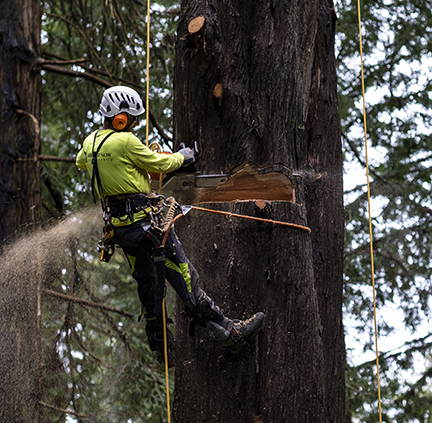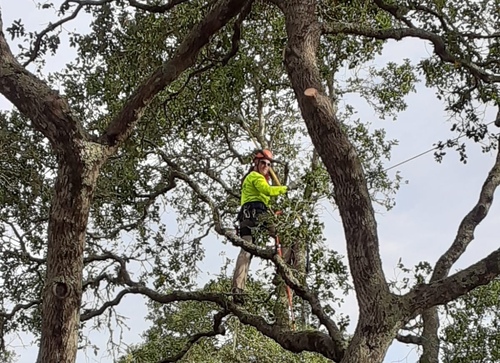How to Become an Arborist
Introduction
Is becoming an arborist a dream of yours? Do you need a step in the right direction? You have come to the right place! This guide will discuss the ins and outs of becoming a certified arborist , what you should expect in this rewarding career, and how to take the first steps.
Ensuring you do everything correctly can be intimidating and time-consuming, but it will absolutely be worth it in the end.
The Extent of an Arborist’s Work

An Arborist Now Team Member Safely Cutting Down a Tree
Job Overview
First, let’s discuss what the job and career will actually entail. Arborists have a variety of tasks that revolve around the care and maintenance of trees. They can be hired by individuals, companies, or communities to ensure their trees are healthy and aesthetically pleasing.
Understanding the Arborist’s Role
An arborist, also known as a “tree surgeon,” is a professional dedicated to the care and maintenance of trees. This role requires a deep understanding of tree biology, soil science, and ecosystem dynamics. Arborists play a crucial role in urban and rural landscapes, ensuring that trees are healthy, safe, and thriving.
Types of Arborist Work
- Residential Arborists: These professionals work with homeowners to manage the trees on their properties. They provide services such as pruning, planting, and diagnosing tree health issues. Residential arborists also offer advice on tree care and maintenance to ensure the longevity and health of trees.
- Commercial Arborists: Commercial arborists work with businesses and organizations to manage trees on larger properties. This can include office parks, golf courses, and public gardens. Their work often involves more extensive planning and coordination to maintain the aesthetic and functional aspects of the landscape.
- Municipal Arborists: Employed by city or local governments, municipal arborists are responsible for the care of public trees. This includes street trees, park trees, and trees on other public lands. They play a key role in urban forestry, helping to develop and implement policies for tree planting, maintenance, and removal.
- Utility Arborists: These arborists work with utility companies to ensure that trees do not interfere with power lines and other infrastructure. This work is critical for preventing power outages and ensuring public safety. Utility arborists need to understand the specific challenges of working near electrical equipment and often require additional training and certifications.

An Arborist Now Team Member Performing Tree Maintenance on Large Oak Branch
Daily Responsibilities
- Tree Assessment and Diagnosis: Arborists regularly inspect trees to assess their health and determine if they are affected by pests, diseases, or environmental stress. This involves using specialized tools and techniques to diagnose problems accurately.
- Pruning and Trimming: Proper pruning is essential for the health and safety of trees. Arborists remove dead or diseased branches, shape trees for aesthetic purposes, and prune to prevent potential hazards, such as branches that could fall on power lines or structures.
- Tree Planting and Transplanting: Arborists select appropriate tree species for specific locations, considering factors like soil type, climate, and space availability. They also transplant trees, ensuring that they are moved and replanted in a way that promotes their long-term health.
- Tree Removal: When a tree is dead, diseased, or poses a safety risk , arborists are responsible for its safe removal. This involves using techniques to minimize damage to the surrounding area and ensuring that the process is carried out safely.
- Soil Management and Fertilization: Healthy soil is critical for tree growth. Arborists analyze soil conditions and provide recommendations or treatments to improve soil health. This can include aeration, mulching, and the application of fertilizers.
- Pest and Disease Management: Arborists identify and manage pests and diseases that affect trees. This can involve the use of pesticides, biological controls, or integrated pest management strategies to protect trees from harm.
- Emergency Tree Care: After storms or other natural disasters, arborists are often called in to address damaged trees. This can involve clearing fallen trees, assessing structural damage, and taking steps to restore the landscape.
Skills and Qualifications
- Technical Knowledge: Arborists must have a deep understanding of tree biology, soil science, and pest management. This knowledge is essential for diagnosing and treating tree health issues.
- Physical Fitness: The job often requires climbing trees, lifting heavy equipment, and working in various weather conditions. Physical fitness and stamina are crucial for performing these tasks safely and effectively.
- Problem-Solving Abilities: Arborists need to assess complex situations and develop effective solutions for tree care. This can involve diagnosing health issues, planning large-scale projects, and managing risks.
- Communication Skills: Arborists must effectively communicate with clients, team members, and the public. This includes explaining tree care practices, providing recommendations, and coordinating with other professionals.
- Safety Awareness: Working with trees involves potential hazards, such as falls, equipment injuries, and exposure to chemicals. Arborists must adhere to safety protocols and use protective gear to minimize risks.
Key Responsibilities
Arborists need an extensive knowledge of trees and plant life. Their skills include:
- Tree Maintenance: Pruning, fertilizing, and general upkeep.
- Planting: Introducing new trees and caring for them throughout their life cycles.
- Tree Rescue: Addressing problems such as pest infestations or diseases.
- Tree Removal: Clearing trees from public spaces after storms or natural disasters.
This career is incredibly important and a is wonderful aspiration for those passionate about nature and environmental health.
Education Requirements

A Textbook and Lined Paper – Image by LUMEN from Pixabay
Educational Pathways
To become a certified arborist, there isn’t a specific degree requirement. You do not necessarily have to have a bachelor’s degree to become an arborist; however, higher education can be beneficial and sometimes preferred by employers. If you decide to go for a degree, there are a number of different courses you will need to take.
- Associate’s Degree: Courses in community forestry, soil fertility, plant pathology, and possibly turfgrass management.
- Bachelor’s Degree: Programs in forestry or urban forestry , including classes in botany, soil science, and forest ecology. A minor in arboriculture may also be available.
Internships
For those wanting to test the waters, internships are an excellent starting point. Internships provide hands-on experience without the financial commitment of a full degree that you may not use. For those in the San Francisco area, Arborist Now offers valuable internship opportunities .
Gaining Experience
On-the-Job Training
In addition to internships, on-the-job training is crucial. Landscaping companies, tree care services, and nurseries often seek individuals who are eager to learn. Responsibilities may include:
- Client Interaction: Communicating with clients about their tree care needs.
- Tree and Plant Identification: Recognizing different species and their needs.
- Basic Maintenance: Using tools for tree care and debris clearing.
These experiences build both tree care skills and important soft skills like customer service and even leadership. If you are the kind of arborist who can confidently handle a crew well, you will be very valuable in your field.
What to Expect
Career Opportunities
After completing your education and gaining experience, numerous career paths are available. Arborists can work for power companies, arborist firms, and municipalities, or they can start their own businesses. Each role offers unique tasks and responsibilities.
Salary and Working Conditions
Salaries for arborists vary based on experience, job description, and location. The average annual salary in the United States is around $40,000, ranging from $24,000 to $64,000.
Expect to spend considerable time outdoors, experiencing various weather conditions and natural elements. Arborists often work with pesticides, power lines, and electric tools, making safety gear and mindfulness critical. You will also be in direct contact with trees as well as the plants and insects that live on and in them. This could open you up to experiencing cuts, bites, and stings on occasion.
Physical Demands
This job involves significant physical labor and climbing, so maintaining good physical condition is essential. Despite the challenges, the role is incredibly fulfilling, contributing to the health and beauty of our natural world.
Conclusion
Becoming an arborist is a noble and rewarding profession. While the journey involves hard work, the satisfaction of preserving and enhancing the natural environment makes it worthwhile. Like any job, it has its challenges, but the positives far outweigh them.
If you have additional questions or are interested in joining the Arborist Now team, don’t hesitate to contact us !
Originally posted on July 29, 2018.


